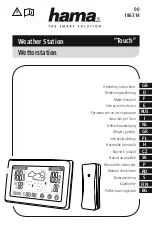
Maintaining the Rain Collector II
7
change. Moving the screws in the positive (+) direction causes the bucket to tip more
times (i.e. give a larger count) for a given amount of water.
Note: Modify both adjustment screws by the same amount.
To check the accuracy of the rain collector, compare the Davis Rain Collector with a tube
type rain gauge. Use a rain gauge with an aperture of at least 4 inches. Any smaller and
the readings obtained may not be accurate. Place the tube type rain gauge directly next to
the Davis rain collector. Compare the totals on three storms. Based on this, develop an
average for how far off the reading are. Adjust the screws to fine tune the reading for the
next three storms if necessary.
Note: Avoid comparison to rainfall readings obtained from television, radio, newspapers, or neighbors read-
ings. Such readings are not an accurate measurement of the weather conditions in your specific sur-
rounding. The rain collector is carefully tested at the factory to conform to the specifications listed in the
back of this manual.
Maintaining the Rain Collector II
For greatest accuracy, you should thoroughly clean the Rain Collector II at least once or
twice a year.
1. Disconnect the rain collector cable from the SIM.
2. Separate the cone from the base.
3. Use a soft damp cloth to clean pollen, dirt, and other debris from the cone, cone
screens, and bucket.
4. Use a pipe cleaner to clear the funnel hole in the cone and the drain screens in the
base. When all parts are clean, rinse with clear water.
5. Reattach the cone and replace the screen.
6. Reconnect the rain collector cable to the SIM.
Troubleshooting Guide
Before calling Technical Support, check the following troubleshooting guide. You may
be able to solve the problem yourself.
•Rainfall is not registering on the console or the console has a large error. Try the follow-
ing:
• Check the cable connections from the sensor to the console. Cable connections
account for a large portion of the potential problems. Connections should be firmly
seated in the jacks and plugged in straight. If you think a connection may be faulty,
try jiggling the cable while looking at the display. If a reading appears intermittently
on the display as you jiggle the cable, the connection is faulty.
• Make sure there is no magnetic, steel, or iron object near the rain collector.
• Make sure the funnel hole in the cone is clear so water can empty into the bucket.
• Make sure the bucket moves freely when tipping to
both sides
. The console should
show an increase in rainfall for each tip of the bucket. (If the bucket does not move
at all, check that you have cut the cable tie that holds it in place during shipping.)
• Make sure the rain collector is mounted on a level surface. Use the adjustment
screws (see “Adjusting the Rain Collector II” on page
7) to adjust the rain collec-
tor’s sensitivity, if necessary.


























